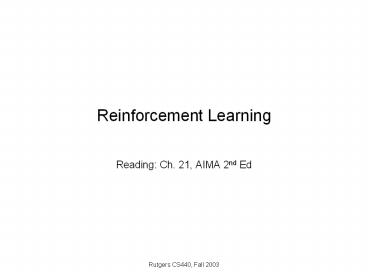Reinforcement Learning PowerPoint PPT Presentation
Title: Reinforcement Learning
1
Reinforcement Learning
- Reading Ch. 21, AIMA 2nd Ed
2
Outline
- What is RL?
- Methods for RL.
- Note only brief overview, no in-depth coverage.
3
What is Reinforcement Learning (RL)?
- Learning so far learning probabilistic models
(BNs) or functions (NNs) - Learning what/how to do from feedback
(reward/reinforcement). - Chess playing learn how to play from feedback
won/lost game. - Learning to speak, crawl,
- Learning user preferences for web searching
- MDP find optimal policy using known model
- Optimal policy maximizes expected total reward
- RL learn optimal policy from rewards
- Do not know environment model
- Do not know reward function
- Know how well something is done (e.g., won / lost)
4
Types of RL
- MDP actions states rewards
- Passive learning policy fixed, learn utility
of states ( rest of model ) - Active learning policy not fixed, learn utility
as well as optimal policy
5
Passive RL
- Policy is known and fixed, need to learn how good
it is environment model - Learn U(st) but do not know P(st st-1,
at-1) and R( st ) from at - Method conduct trials, receive sequence of
actions, states and rewards (at,st,Rt) ,
compute model parameters and utility
at NA A A A
st NL NL L L
rt -20 0 20 20
6
Direct utility estimation
- Observe (at,st,Rt), estimate U(st) from counts
inductive learning
Sample 1
Sample 2
at NA A A A
st NL NL L L
rt -20 0 20 20
at NA A A NA A
st NL NL L L L
rt -20 0 20 5 20
- Example (?1)
- Sample 1 U(NL) -20 0 20 20 20, U(NL)
0 20 20 40 - Sample 2 U(NL) -20 0 20 5 20 25,
U(NL) 020520 45 - On average, U(NL) ( 20402545 ) / 4
- Drawback does not use the fact that utilities of
states are dependent (Bellman equations)!
7
Adaptive dynamic programming
- Take into account constraints described by
Bellman equations
- AlgorithmFor each sample, each time step
- Estimate P(st st-1, at-1)E.g., P(LNL,A)
(L,NL,A) / (NL,A) - Compute U(st) from R(st), P(st st-1, at-1),
using Bellman equations or update - Drawback usually (too) many states
8
TD-Learning
- Only update U-values for observed transitions
- Algorithm
- Receive new sample pair, (st,st1)
- Assume only transition st ? st1 can occur
- Compute update of U
- Does not need to compute model parameters!( Yet
converges to the right solution. )
Old value
Old value
New value
Value computed fromBellman equation

